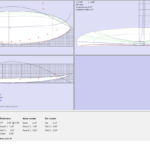HPC User Report from B. Jakubaß & S. Falk (Division of Phoniatrics and Pediatric Audiology)
Numerical investigation of a surfer-surfboard-system on a free surface
Computational fluid dynamics (CFD) is used to simulate the governing fluid field around a surfboard with plugged fins in interaction with a surfer to investigate the fluid dynamical characteristics of this surfer-surfboard-system. The aim of the project is: (1) develop an adequate simulation model which can reproduce a common surf motion with the surfer-surfboard-system, and (2) to find a set of parameters which describes and defines the maneuverability, stability, and speed of a surfboard.
Motivation and problem definition
CFD is used in nearly all kinds of sports to achieve better equipment and performances, but in surfboard design and construction, still, the surfboard shapers’ experience is highly dominating. The high spatial and temporal resolutions in combination with unconfined access to the simulation region are great advantages of CFD compared to the still existing try and error method with a physical test setup.
The basic idea of our studies is to develop a CFD model that can fully reproduce a surfer-surfboard-system interaction in static and dynamic common surf motions. If an adequate model is established, the next step is to acquire a knowledge base for the fluid dynamical characteristics of the surfer-surfboard-system and to define a system of objective parameters to categorize the abilities of a surfboard-fin-system.
Methods and codes

We use the commercial software package STAR-CCM+ (Siemens) with the finite volume method to solve the unsteady incompressible Navier-Stokes equations for the flow motion around the surfboard-fin-system. The surfboard is placed on the free surface of the Eulerian multiphase inserted into a three-dimensional rectangular fluid volume. Because of the complexity of the surfer-surfboard-system in interaction with the fluid flow and therefore the high mesh resolution around the board and the size of the simulation region to enable a natural surf motion, the use of high-performance computing (HPC) systems is inevitable. Therefore, five to seven computer nodes of RRZE’s cluster are used to perform the simulations in this study.
Results

To reach the previously described aim of objective parameters for categorizing the surfboard-fin-systems characteristics, we will investigate the following forces and moments:
- Lift and drag of the fins
- Buoyancy and drag of the surfboard
- Yaw-, roll and pitch moments produced by the surfer-surfboard-system
We suppose that appraisal factors for the stability and maneuverability of the surfboard are the moments that are acting on the surfer-surfboard-system. The moments that arise simultaneously are strongly dependent on the lift and drag forces of the fins and the buoyancy and drag of the surfboard.
Outreach
The project is only running since January 2019.
Cooperation
- Prof. Dr. med. Rolf Janka – Department of Radiology at the University Hospital Erlangen: Responsible for the CT Scans of the surfboard and the fins.
- Dr. Roberto Grosso – Computer Graphics Group at the Friedrich-Alexander University Erlangen-Nürnberg (FAU): Responsible for the segmentation and post-processing of the CT data.
- Jerry O’Keefe – Soul Stix Surfboards San Clemente, CA (USA): Provides the surfboard CAD data and shaped the 6’8’’ surfboard.
- Tom O’Keefe – Daum Tooling Inc. San Clemente, CA (USA): Provides fin CAD data and supports us in the discussion of the simulation results.
- Prof. Dr.-Ing. Stefan Becker – Institute of Process Machinery and Systems Engineering at the Friedrich-Alexander University Erlangen-Nürnberg (FAU): Support in fluid mechanics.
Researcher’s Bio and Affiliation
Bernhard Jakubaß obtained his Master degree in Medical Engineering at the Friedrich-Alexander University Erlangen-Nürnberg (FAU) from Prof. Dr.-Ing. Michael Döllinger (Head of research) at the division of Phoniatrics and Pediatric Audiology at the Department of Otorhinolaryngology, Head and Neck Surgery of University Hospital Erlangen and Medical Faculty of FAU and is currently a PhD student and scientific assistant under the supervision of PD Dr.-Ing. Stefan Kniesburges and Prof. Dr.-Ing. Michael Döllinger.
Sebastian Falk obtained his Master degree in Mechanical Engineering at the Friedrich-Alexander University Erlangen-Nürnberg (FAU) and is currently a PhD student and scientific assistant under the supervision of PD Dr.-Ing. Stefan Kniesburges and Prof. Dr.-Ing. Michael Döllinger (Head of research) at the division of Phoniatrics and Pediatric Audiology at the Department of Otorhinolaryngology, Head and Neck Surgery of University Hospital Erlangen and Medical Faculty of FAU.
